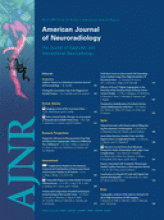Abstract
BACKGROUND AND PURPOSE: Annular tears and nuclear degeneration often occur concurrently, but their temporal association remains unknown. The purpose of this study was to assess whether annular tears precede nuclear degeneration and whether the evolution of nuclear degeneration is affected by presence of annular tears.
MATERIALS AND METHODS: From our radiology report data base, 46 patients with back pain were identified, each with 2 previously obtained lumbar spine MR imaging examinations in the absence of any spinal intervention. Two neuroradiologists evaluated intervertebral disks between the T12 and S1 segments in a random blinded fashion. Hyperintense foci within the anulus were noted to diagnose annular tears. The signal intensity of disks was graded on an ordinal scale, and overall degeneration, on the scale of Pfirrmann et al. Mean signal-intensity and degeneration grades were calculated for disks with and without annular tears, and differences were tested for statistical significance. Mean changes in these grades on follow-up studies were also calculated and compared for 2 groups.
RESULTS: The study included 13 men and 33 women, with a mean age of 53.6 ± 15.2 years (range, 20–88 years). The mean interval between the imaging studies was 31.8 months. Annular tears were seen in 203 of 276 (73.5%) disks. Twenty-one of these had normal central signal intensity. Compared with disks without annular tears, disks with annular tears demonstrated significantly higher degeneration grades and a higher change in these grades on follow-up.
CONCLUSIONS: Annular tears occur in the early stages of disk degeneration and are associated with a faster subsequent nuclear degeneration.
- Copyright © American Society of Neuroradiology







